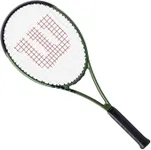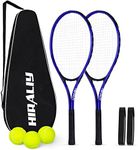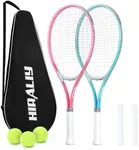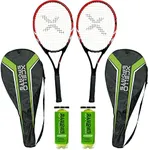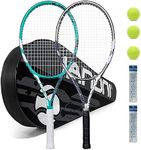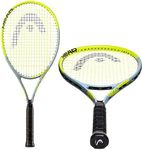Buying Guide for the Best Tennis Racquets For Beginners
Choosing the right tennis racquet as a beginner is crucial for developing your skills and enjoying the game. The right racquet can help you improve your technique, reduce the risk of injury, and make the game more enjoyable. When selecting a tennis racquet, consider factors such as weight, head size, balance, string pattern, and grip size. Understanding these key specifications will help you make an informed decision and find the best fit for your needs.WeightThe weight of a tennis racquet affects how it feels in your hand and how it performs on the court. Lighter racquets (8-10 ounces) are easier to maneuver and are ideal for beginners as they help with control and reduce the risk of arm fatigue. Medium-weight racquets (10-11.5 ounces) offer a balance between power and control, suitable for players who are starting to develop their skills. Heavier racquets (11.5+ ounces) provide more power and stability but require more strength to handle, making them better suited for advanced players. As a beginner, you should start with a lighter racquet to build your confidence and technique.
Head SizeThe head size of a tennis racquet refers to the surface area of the racquet's string bed. Larger head sizes (100-115 square inches) provide a bigger sweet spot, making it easier to hit the ball and generate power. This is beneficial for beginners who may not consistently hit the ball in the center of the racquet. Mid-sized head sizes (85-100 square inches) offer a balance of power and control, suitable for players who are improving their accuracy. Smaller head sizes (85 square inches or less) provide more control but require precise hitting, making them better for advanced players. Beginners should opt for a racquet with a larger head size to help with power and forgiveness.
BalanceThe balance of a tennis racquet refers to the distribution of weight along the length of the racquet. Head-light racquets have more weight in the handle, making them easier to maneuver and control, which is helpful for beginners. Head-heavy racquets have more weight in the head, providing more power and stability but can be harder to control. Even-balanced racquets offer a compromise between power and control. As a beginner, a head-light or even-balanced racquet is recommended to help you develop your control and technique.
String PatternThe string pattern of a tennis racquet refers to the number of main and cross strings on the racquet's head. Open string patterns (fewer strings, such as 16x19) provide more power and spin but may wear out faster. Dense string patterns (more strings, such as 18x20) offer more control and durability but less power and spin. Beginners may benefit from an open string pattern as it helps generate more power and spin, making it easier to hit effective shots. As you progress, you can experiment with different string patterns to find what suits your playing style.
Grip SizeThe grip size of a tennis racquet is the circumference of the handle and is crucial for comfort and control. Grip sizes are usually measured in inches or millimeters. A grip that is too small can cause the racquet to twist in your hand, while a grip that is too large can be uncomfortable and reduce your ability to control the racquet. To find the right grip size, hold the racquet as you would when playing and check if there is enough space to fit your index finger between your fingers and palm. Beginners should ensure they choose a grip size that feels comfortable and secure in their hand to prevent injury and improve control.







